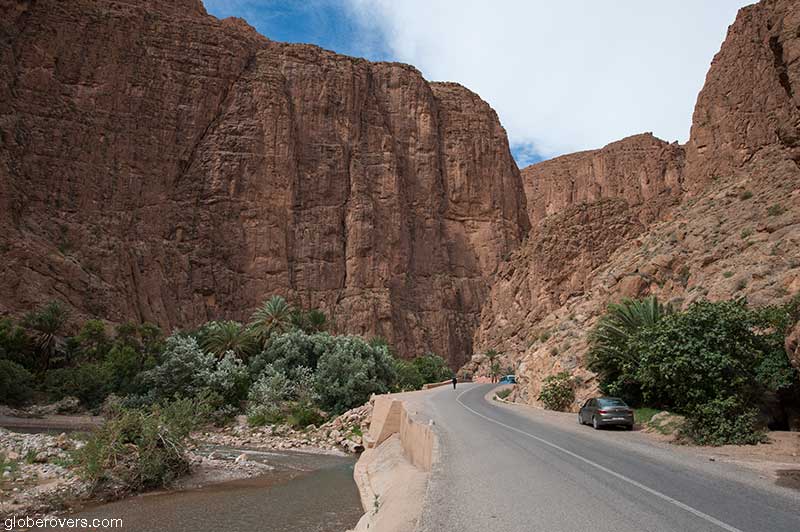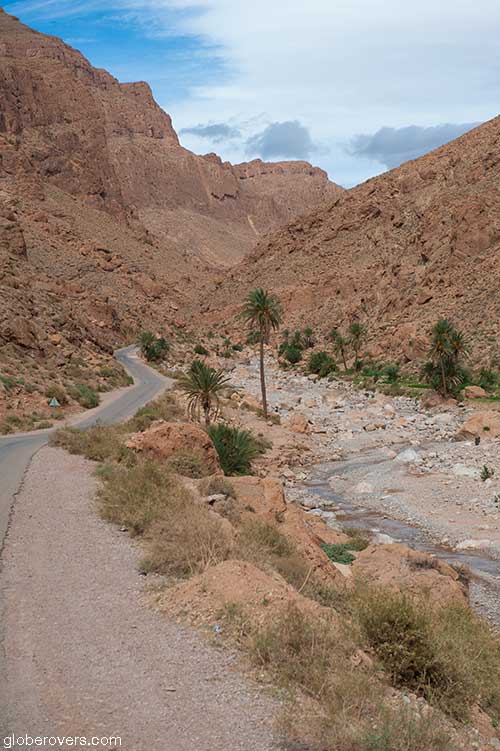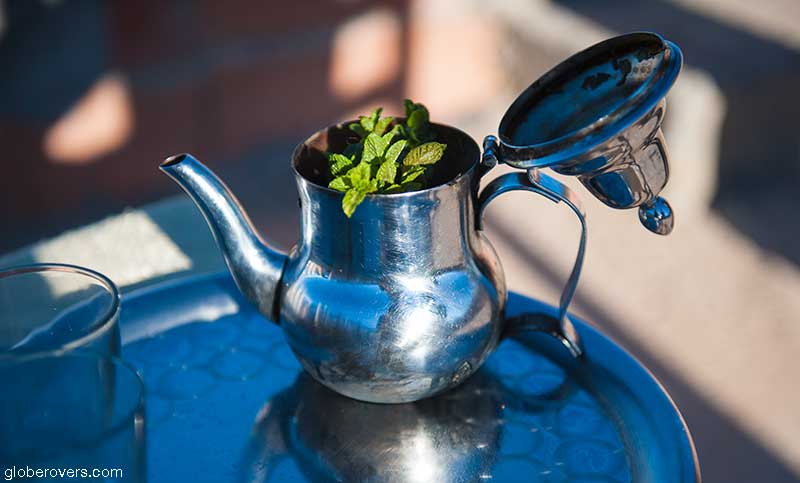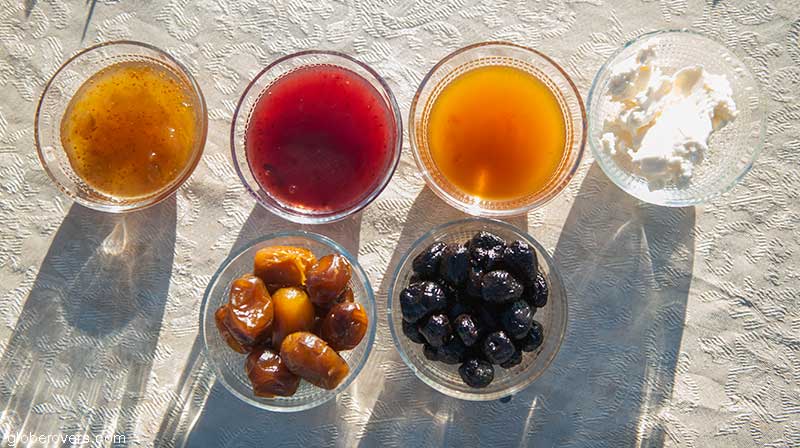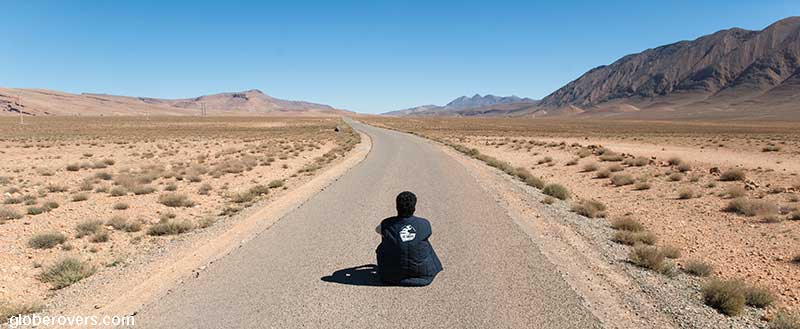
The road from Marrakech goes 200 km (124 mi) south to Ouarzazate. From here its a long but interesting semi-desert road 170 km (106 mi) east to Tinghir. While Tinghir is interesting, turn north in the central part of town to get to Gorges du Todgha. Just a few kilometres north of Tinghir the road becomes very scenic. Stay in Gorges du Todgha for a night or two to explore this beautiful part of Morocco, and then drive north to the small village of Tamtatouchte.
Stay a night or two in one of the few guesthouses. The road from Tamtatouchte up the High Atlas Mountains to the village of Agoudal is stunning. From Agoudal the road turns southwest through and over the mountains to Gorges du Dadès.
This region includes Gorges du Todgha, Gorges du Dadès, and the High Atlas Mountains, and is arguably the highlight of any trip to Morocco.
Stay in Gorges du Todgha for a night or two to explore this beautiful part of Morocco, and then drive north to the small village of Tamtatouchte. Stay a night or two in one of the few guesthouses. The road from Tamtatouchte up the High Atlas Mountains to the village of Agoudal is stunning. From Agoudal the road turns southwest through and over the mountains to Gorges du Dadès.
The road from Tamtatouchte to Gorges du Dadès should only be driven when it is dry and in good condition (get an update from Tamtatouchte). While a normal car is ok for this road, most car rental companies technically do not approve this road. It is best to have a 4-wheel drive. The distance from Tamtatouchte up to Agoudal and then southwest to Gorges du Dadès is about 160 km (100 mi).
From Gorges du Dadès back to Marrakech via Ouarzazate is 330 km (205 mi). Public transport on this route is not suitable if you have a tight schedule. Either rent a vehicle or take a group tour.
Why travel south of the High Atlas?
- The low-down: This is one of the most beautiful parts of the world! Make sure to stay a few nights in the area to do some hiking.
- The brightest highlight: The road through Gorges du Todgha and the winding road just north of Gorges du Dadès are unforgettable experiences!
- Intrepid destination: Absolutely. Especially if you travel in the off-season, but watch the weather. When wet, the road between Tamtatouchte and Gorges du Dadès via Agoudal will be dangerous. Even worse in winter when the mountains get a fair share of snow.
- Globerovers score (10 is highest): I was truly impressed with this entire area. I’ll score it 8.8/10.
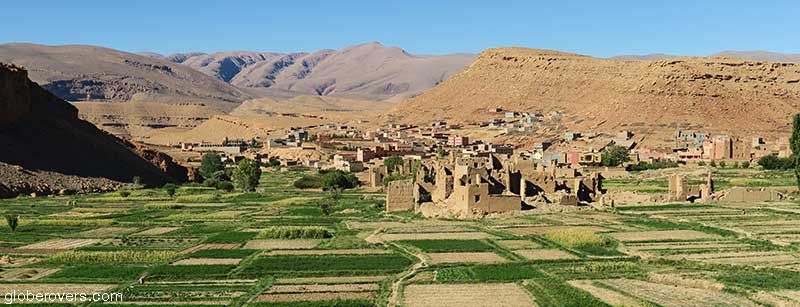
Table of Contents
Tinghir
Right in Tinghir town is the old Ksar Tinghir, also referred to as “Jewish Quarter”. Over the years it has lost its ramparts and its six monumental gates but it still retains a certain charm with its narrow alleys and adobe walls.
It is also worth stopping by the 1944-built Kasbah of Sheikh Bassou that has been tastefully converted into Hotel Tomboctou. In addition to admiring the building, check out the beautiful lobby and try the restaurant.
On a hill out of town are the ruins of the 1919-built Glaoui’s Kasbah that is in a deplorable state. It has been abandoned since 1956.
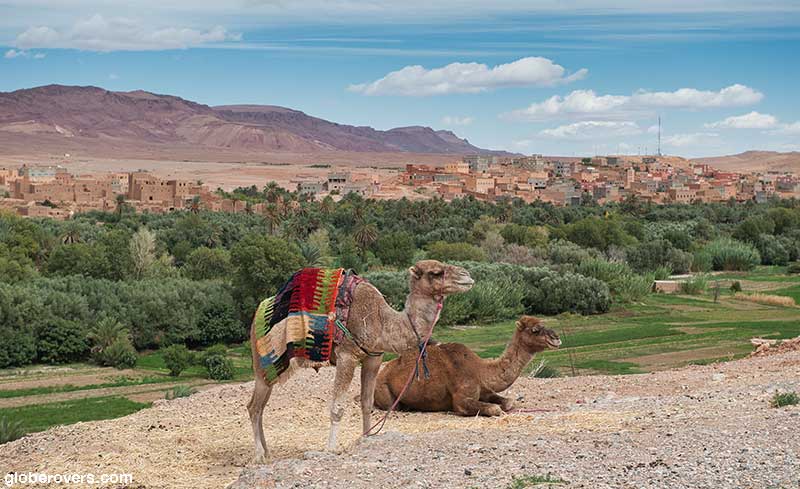
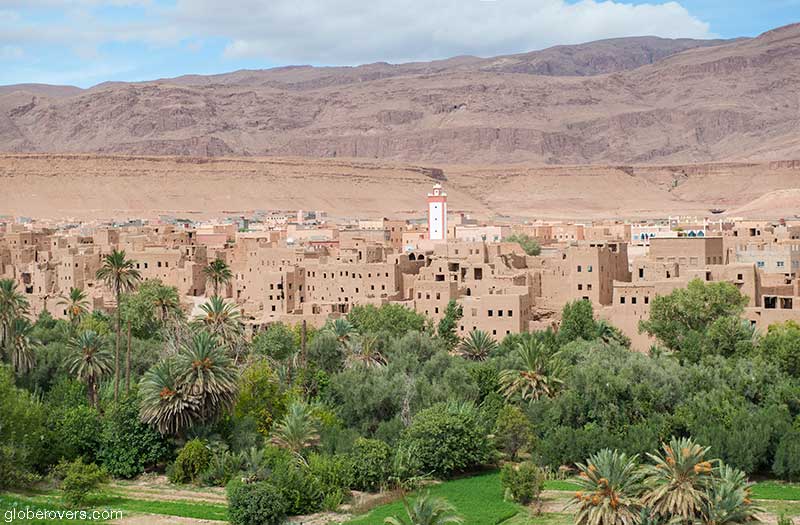
Gorges du Todgha
Written as Todgha Gorge or Todra Gorge, and locally known as Les gorges du Todgha or Vallée du Todgha, this incredible canyon is located in the southeastern part of the High Atlas Mountains, about 5 km north of the oasis town of Tinghir. Within a few minutes’ drive north of Tinghir, past palm groves and Berber villages, the landscape starts changing from a lush oasis to a parched canyon along the valley of Wadi Todgha.
This is one of the roads you will never ever forget!
You will know you have arrived when you see the massive walls of pink and grey rock closing in along the road as if you are being sucked in by mother earth! The gorge takes its most spectacular form about 15 km north of Tinghir when it is time to stop, look up, and get the cold chills!
Gorges du Todgha has spectacularly carved out cliff-sided canyons which in some places are as little as 10 m wide with sheer, smooth rock walls over 160 m high on each side.
While turbulent waters of the Todgha River carved out this canyon over centuries, what is left today is a tiny ice-cold meandering stream which flows alongside the small paved road. During rainstorms, the river engulfs this road, which makes the canyon impassable, so in the rainy season call ahead to make sure the roads are safe.
As you enter the gorge, it is as if mother earth swallows you down a long, deep, brown throat. Stop every few steps and look up. It is a dizzying and mesmerizing sight!
The canyon is popular among rock climbers with more than 150 different climbing routes on 40 different sectors available to choose from. Some of the popular routes are the Plage Mansour, Pilier de Couchant, Can Güllich, Les Jardins and the Satanicos Sector. If rock climbing isn’t your forté, then enjoy the hiking or merely walk a few kilometres along the road and the small river to appreciate the natural surroundings.
The variation of temperatures in the gorge can be quite extreme. While blazing hot during midday, the late afternoons and nights can get quite chilly with a fair amount of cold weather and snow in winter. The best time of the day to visit is early in the morning when the sunshine briefly illuminates parts of the gorge in a soft golden hue. Try to stay for the day because the gigantic rock walls magically change colour as the day progresses. The best time of the year is any time except winter, which means plan your trip from around April to the end of October.
A couple of entrepreneurial locals have put up a few make-shift shops next to the road and river and are selling colourful cloths, which seen positively from a photographer’s point of view, create a lovely contrast to the pink, brown, and grey rock formations. They also bring a much-needed income to the locals, who in this part of the world don’t have many options to make ends meet.
Unless the river has flooded and cleaning is not completed, the road is generally good and does not require a 4×4 vehicle.
While camping is popular along the entire canyon, a few auberges, riads and kasbahs are welcoming tourists to stay overnight in the area.
Public transportation in this part of Morocco is limited to collective “grand” taxis which normally take six cramped passengers – two in the front and four in the back. It only leaves when full. A much better choice is to rent a vehicle in Marrakech or Ouarzazate.
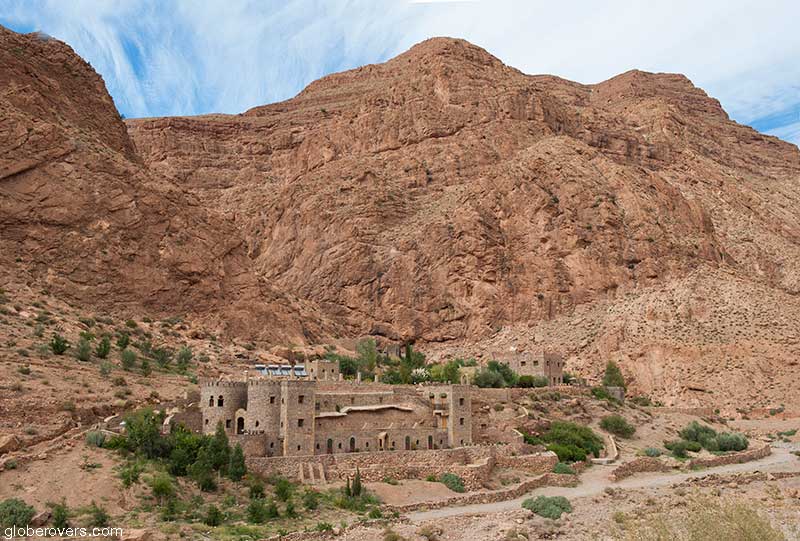
Tamtatouchte – Sleepy Berber village
About 20 km north of Gorges du Todgha, the winding well-maintained asphalt road leads to the small Berber village of Tamtatouchte. En route, look out for the small whitewashed marabout (pilgrimage chapel dedicated to a local saint) on the right side of the road.
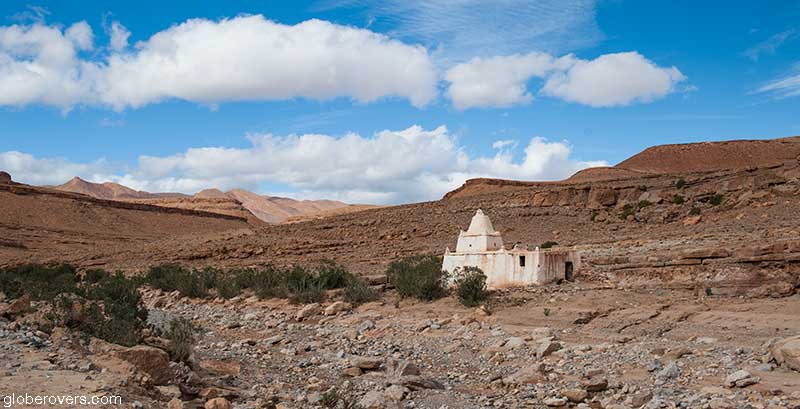
Tamtatouchte is a drab village located at the foot of the High Atlas Mountains. Further north from here the road winds through spectacular mountain scenery. The older buildings in the village are adobe-made, while the newer places are mostly constructed from cement.
Take a look at some of the local carpet weavers of Tamtatouchte, and you might just as well buy one to take home
Once you start meeting the locals at Tamtatouchte, you will feel the warmth of the Berber people. Foreign tourists are scarce and the locals are incredibly friendly and inquisitive.
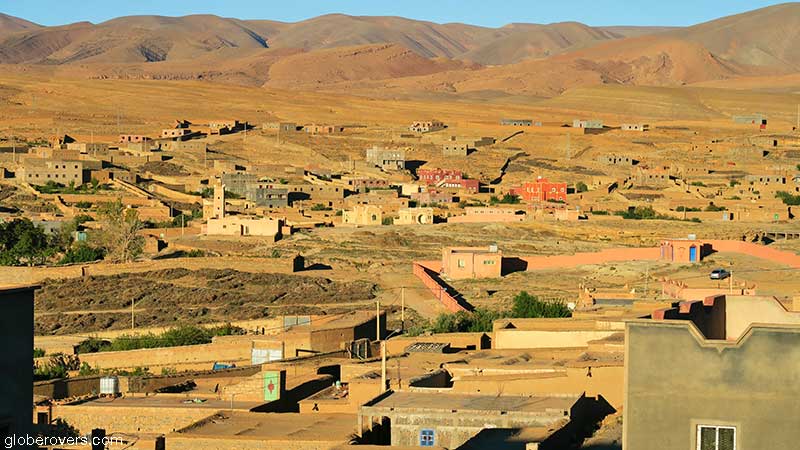
A good introduction to the local people and their customs starts with a mint tea on the veranda of Auberge Amazigh, which literally means “the home of the Berber people”. Pick one of the cosy rooms in this traditional home and head out to the veranda where your friendly host, Hamid, will serve you the customary mint tea in a glass, complete with condiments such as black and green olives, and fleshy dried dates. Hamid loves to talk about his people, and while his English language skills are limited, he gets his message across. Knowing a little French will certainly help to better communicate with him.

Tea at Auberge Amazigh, Tamtetoucht, Morocco 
Olives and jams at Auberge Amazigh, Tamtetoucht, Morocco
After tea, hike higher up the village to survey the surroundings from the top, then head down below towards the old part of town to inspect some of the old derelict buildings. Near the small river are large swatches of fertile plots where the locals, men and women, work tirelessly with their donkeys to plough the lands and control the weeds.
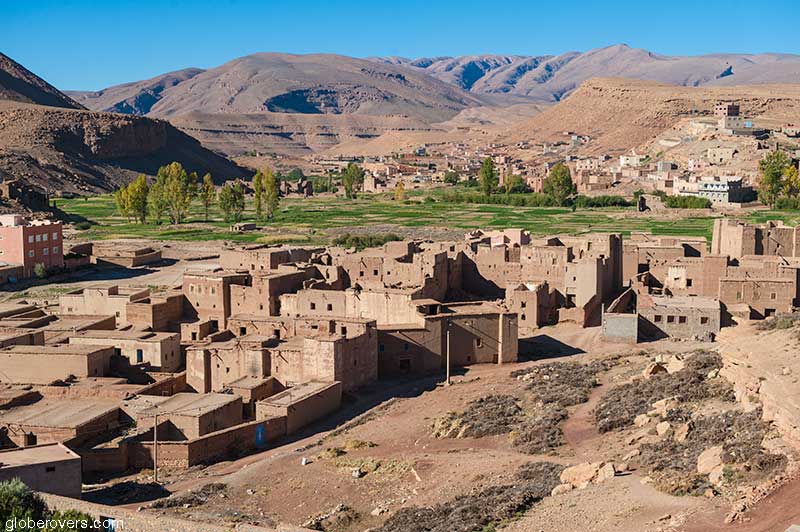
As you walk through the village, you will quickly attract the attention of a few kids who are willing to show you around and perhaps score a short game of football with you. They may even introduce you to their makeshift see-saw, which is merely a wooden log balanced in a fork of a tree. Go ahead and see-saw with the kids. They so love it!
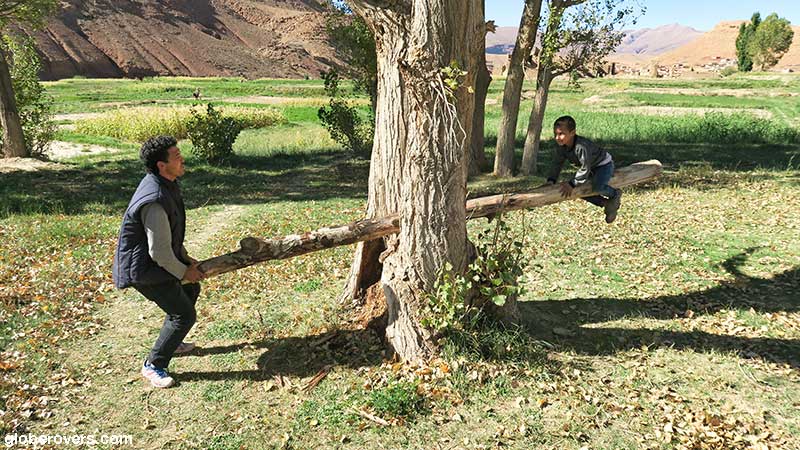
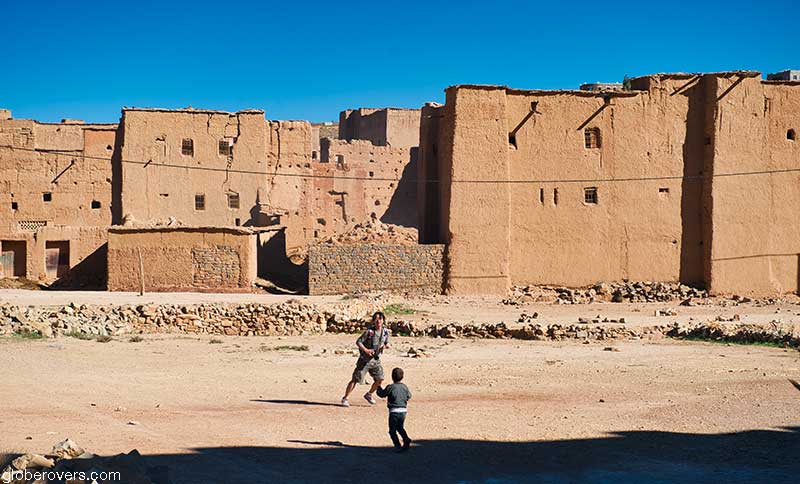
At night, Hamid will serve up steaming lamb or vegetarian tajine stew with a very generous serving of couscous. Sitting in front of the fireplace, Hamid will then grab his traditional “loutar” (three-string Berber guitar) and start playing while singing traditional love songs. He may likely be joined by his friend with his “aloun” percussion instrument to play along. What a show!

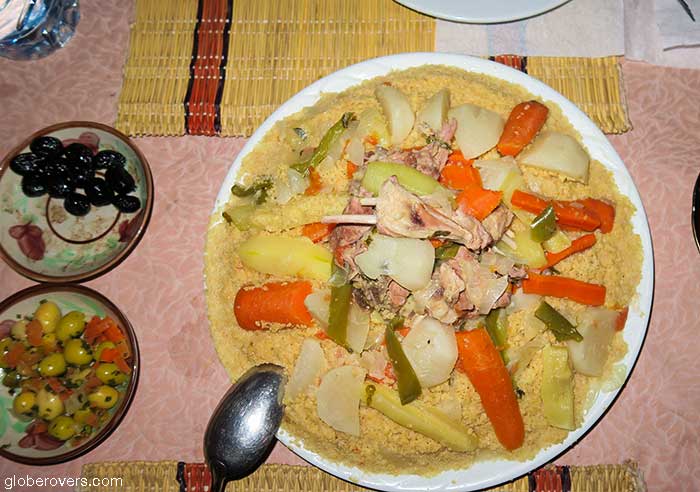
Tamtatouchte Salt Mines
A short drive north of Tamtatouchte village, followed by a long hike, leads you past some interesting and barren mountain landscapes to the salt mines.
The walk along a small path goes past a long aqueduct which channels water from the high mountains all the way down to the villages in the nearby valley. Walk past a waterfall and continue until you see some light salt deposits on the ground and on the rocks.
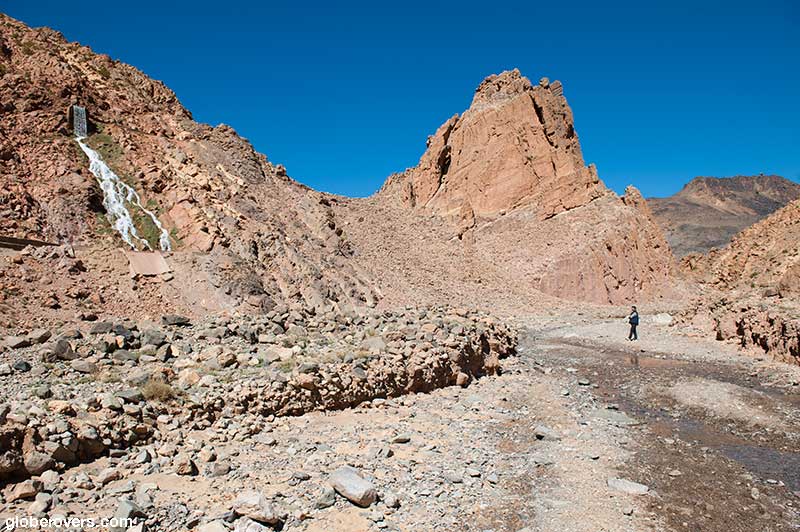
In this area you will find several open salt mines and salt caves, some which are quite deep and dangerous. Be careful not to slip and fall into the abyss.
Notice the scrape marks all over these caves where locals sporadically come to mine the salt. The large and heavy bags are then transported on donkeys back to the villages. Back-breaking work for both man and beast!
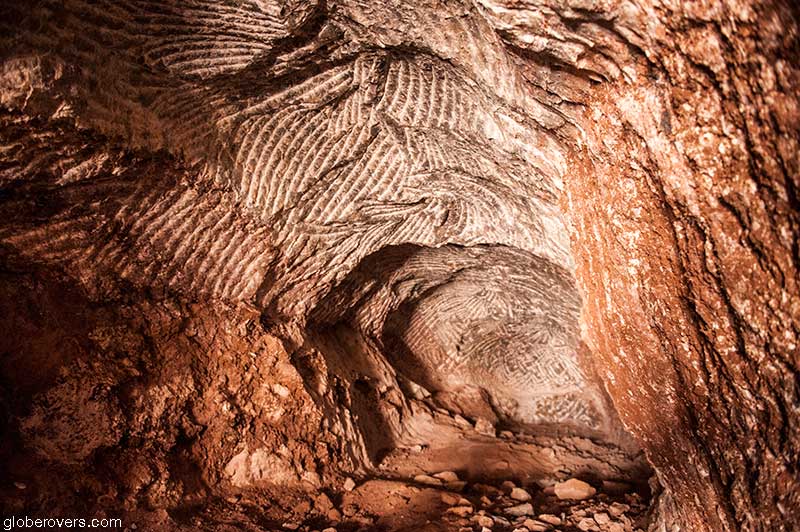
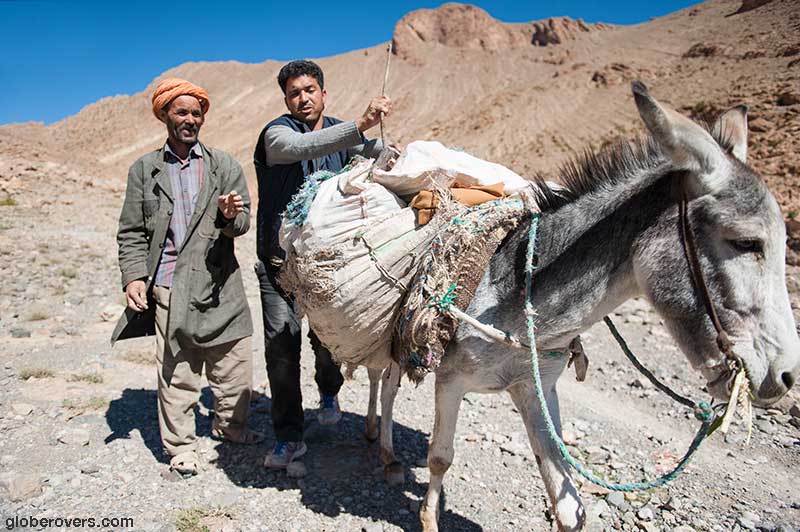
The High Atlas Mountains
North Africa’s highest mountain range, the High Atlas, is referred to by the Berber people as ‘Idraren Draren’ (Mountains of Mountains) and it is a delight to the eyes and a hiker’s paradise from spring through to autumn.
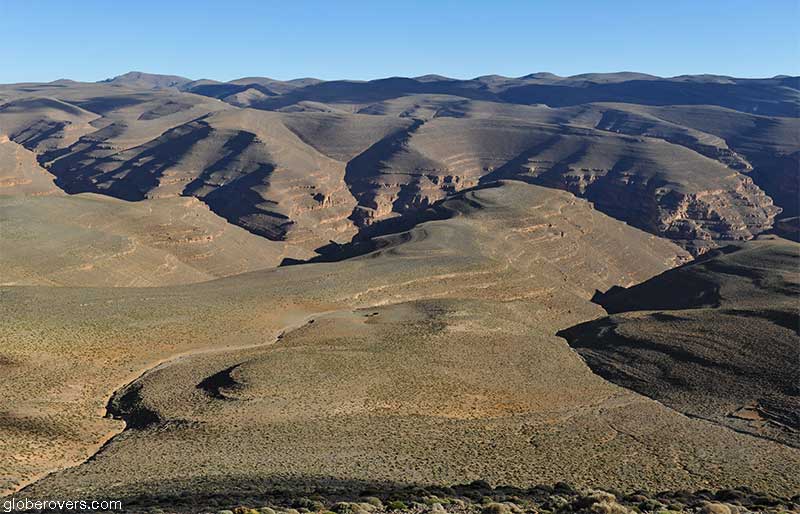
The “High Atlas” mountains stretch diagonally across Morocco for almost 1,000 km from near the Atlantic Coast in the west, up to the northeast towards Algeria. To its immediate north lies the “Middle Atlas” mountains and to its south is the “Anti-Atlas”, also known as the “Little Atlas”, which runs diagonally along the fringes of the Sahara Desert, along the Algerian border.
Get mesmerized in Africa’s highest mountains!
The many saw-toothed peaks of the High Atlas, some over 4,000 m high, act as an efficient weather barrier between the mild Mediterranean climate to the north and the encroaching sweltering winds from the Sahara Desert in the south. Its many high peaks can be snow-covered between September and May which allow for skiing. In spring the melting snow provides ample water which flows into the fertile valleys. Unless you are planning winter sports, the best time to visit is from June to the end of October.
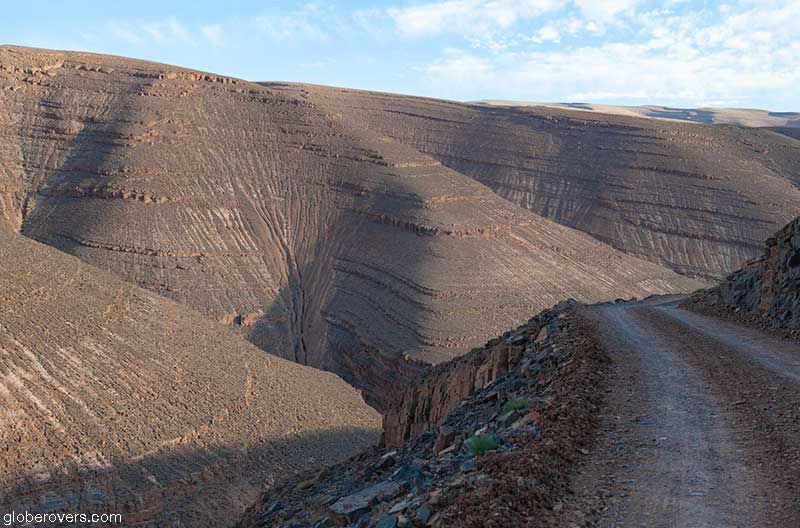
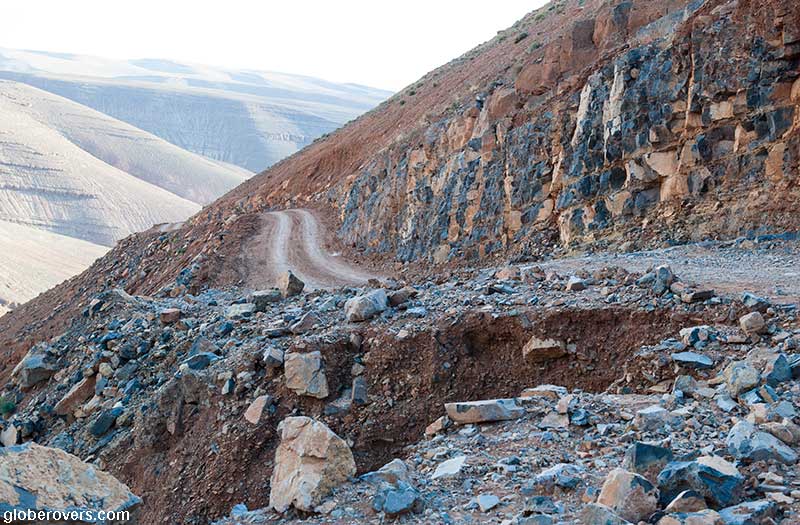
The road northwards from Tamtatouchte to Agoudal via the small village of Ait Hani is very scenic. From Agoudal the road goes north to Imilchil and its twin lakes, or alternatively choose the tiny dirt road southwest towards Dadès Gorges. This road is not for the faint-hearted, especially if you don’t have a 4×4 or off-road vehicle. Go ahead and take this road, the next 100 km to Dadès Gorges is an experience you will never forget!
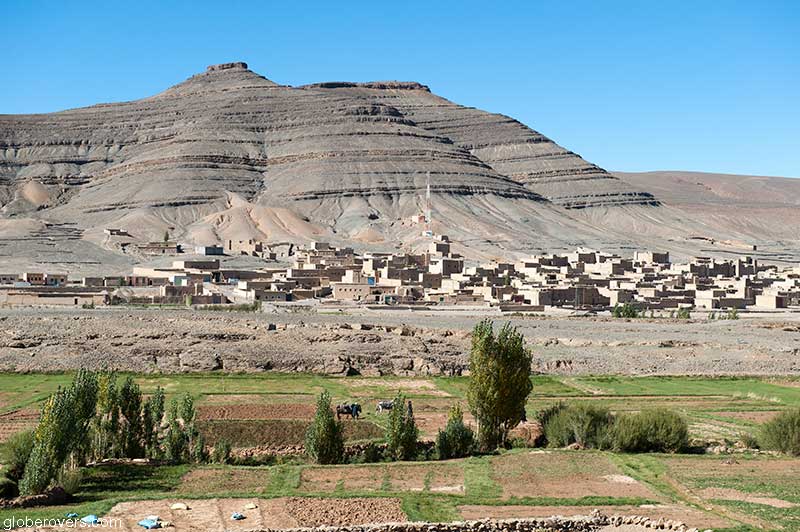
The mountain scenery is stunning and the road is somewhat nerve-racking.
Gorges du Dadès
Gorges du Dadès offers stunning scenery and is aptly referred to as “the road of a thousand kasbahs”. The spectacular drive winds through peaceful desert landscapes, quaint villages and palm groves along this stretch of the Dades Valley, located between the High Atlas Mountains to the north and the Small Atlas Mountains to the south. Tens of kasbahs line the road alongside the palm trees.
Whether you prefer hiking, rafting, rock climbing or just sitting back staring over the canyon, you will find it all right here! Further south towards the Sahara Desert is the Jebel Sarhro lunar-scape in the Small Atlas, famous for its surreal landscapes reminiscent of the “Red Rock Country” in the American State of Utah.

The Dades Valley has an untamed landscape, with the possibility of snow to the north and the arid semi-desert to the south. The savage grandeur of the gorge is somewhat reminiscent of America’s Grand Canyon. The small Dades River meanders through the valley quenching a long stretch of wheat paddies, fruit trees, walnut trees, silver birch and almond trees, all set against an extraordinary scenic backdrop of reddish rock formations.
Visitors come from afar to drive on one of the world’s most incredible roads. Described by some as “one of the more dangerous roads in the world”, it’s beautiful setting far outweighs its danger.
However, the greatest spectacle of Gorges du Dadès is the entry point when driving from Agoudal in the north, or the point of exit when driving from Boumalne Dades in the south. This section of the road is often listed among the scariest roads in the world. However, you may agree that it is far more scenic than scary, if you have strong nerves! At the top of the scary winding road is the infamous Cafe Restaurant Hotel Timzzillite, which is not recommended other than for the views.
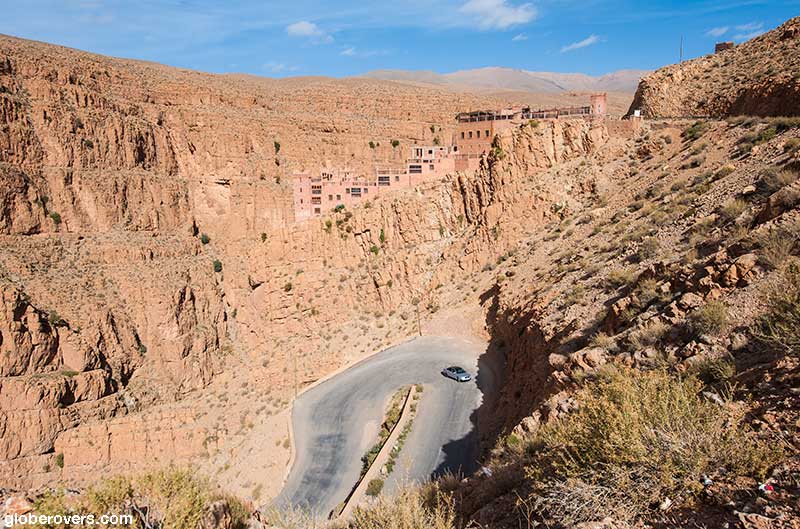
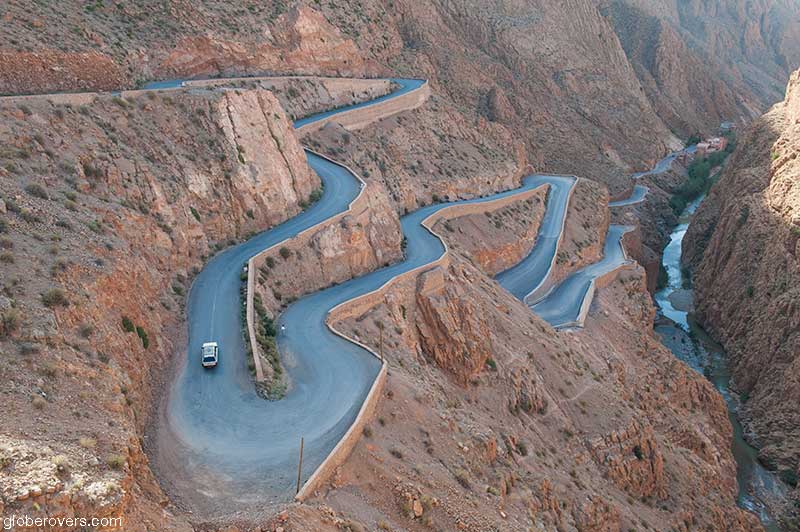
All adds to an adrenalin rush which you can reset once you have successfully passed through the hairpin winding road of “Dadès Gorges Road” immediately north of Dadès Gorges village. A road referred to as one of the most dangerous in the world!
The best service, accommodation and prices are to be enjoyed down in the valley. Contact the friendly and charming Youssef Ijoud at Auberge La Fibule Du Dades (lafibuledudades@gmail.com) to book one of his cosy rooms. His auberge is truly an experience and the authentic Berber meals and service are incredible!
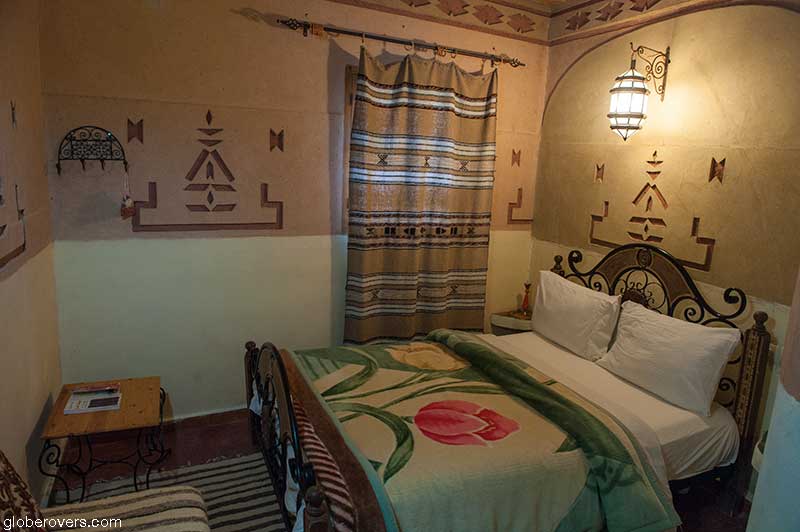
As with the rest of this region, avoid midsummer and winter. The best time to visit the valley is between March and May, while the mountains are cooler, so the best time to visit the mountains is from May to July. From September to the end of October is also a good time.
☛ Read more: 7 Unforgettable Morocco Travel Adventures
☛ Read more: Marrakech to Fint Oasis
☛ Read more: Atlantic Coast: Essaouira to El Jadida
☛ Read more: 9 Great Travel Experiences in Morocco

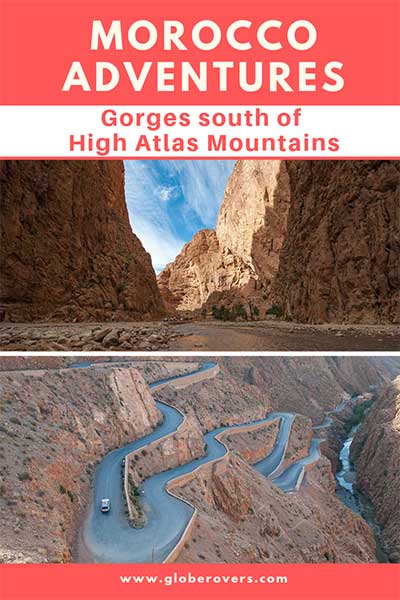
Further reading
- Coming soon

Blog post and photos by Peter who has been travelling almost full-time since 2005 and has been to over 122 countries. He visited several countries, such as Japan, more than 20 times. Peter is Editor-in-Chief and Publisher of GlobeRovers Magazine, an independent travel magazine focused on intrepid destinations.



